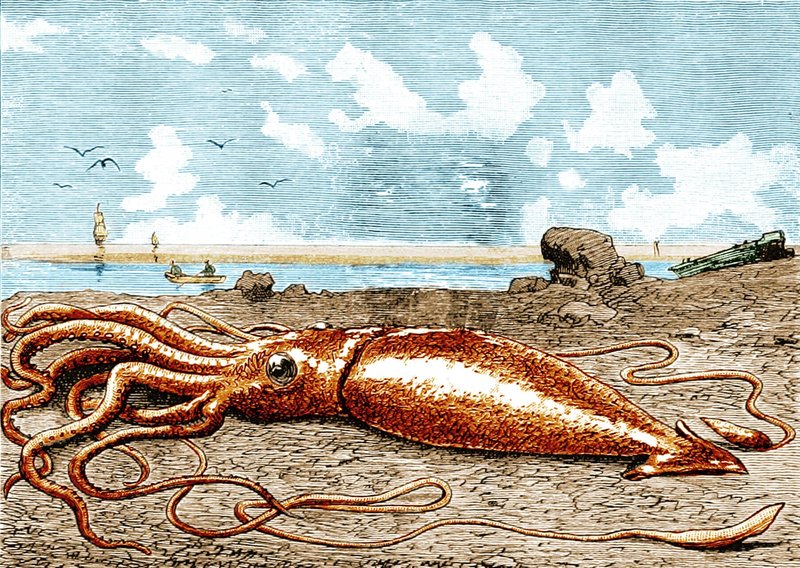
Imagine you’re at a cozy coffee shop, chatting about the ocean’s wonders. You might talk about how the giant squid has inspired countless tales, from sailors’ yarns to blockbuster movies. But what’s the truth behind these myths? Let’s dive deep into the cultural beliefs and myths surrounding the giant squid, exploring how this fascinating creature captured our collective imagination.
The Origins of the Giant Squid Myth
The giant squid has been part of human storytelling for a long time. These tales often start with early sailors, who spent months at sea, far from the shore. With limited knowledge of marine biology and a healthy dose of imagination, they spun stories of monstrous creatures lurking beneath the waves.
One of the earliest recorded mentions of a giant marine creature is the kraken. Originating from Scandinavian folklore, the kraken was said to be a colossal sea monster that could drag entire ships under the surface. While it may not be the same as the giant squid, this myth reflects how ancient communities interpreted the unknown. Imagine being out in the dark ocean at night—every splash and shadow could easily be transformed into a terrifying sea beast.
As ships advanced and exploration increased, more reports of large squid began to emerge. Remarkably, these accounts often blended fact with fiction. Though the giant squid is a real creature, stories about its size and behavior were likely exaggerated. Over time, the true nature of the giant squid became tangled in myth, making it difficult to separate reality from imagination.
How the Giant Squid Became a Cultural Icon
Across different cultures, the giant squid holds a significant place in various myths and artworks. In Japan, for instance, some legends talk about the Akkorokamui, a massive cephalopod that can generate bright light and is said to be deadly. Such stories showcase how the giant squid’s image morphed into something both fascinating and fearsome.
In art, the giant squid has inspired countless works, from paintings to films. Who can forget the iconic scene of a giant squid attacking ships in movies like “Pirates of the Caribbean”? These portrayals often amplify the creature’s mystique, depicting it as a fierce and unstoppable force. This connection between the giant squid and folklore highlights humanity’s deep-seated fascination with the ocean’s mysteries.
Interestingly, the squid’s cultural relevance isn’t just about being a monster. It also symbolizes the unknown—the things we can’t see or understand. Much like our fears of the dark, the giant squid represents what lies beneath the surface of our everyday lives. It prompts us to ask questions: What other wonders and terrors are out there, waiting to be discovered?
The Science Behind the Giant Squid
When we peel back the layers of myth, we find an incredible creature that truly exists. The giant squid (Architeuthis dux) can grow up to 43 feet long, making it one of the largest invertebrates on Earth. Despite its size, much about the giant squid remains a mystery to scientists, just like the myths that surround it.
Unlike the terrifying beasts of folklore, the real giant squid tends to be elusive. These creatures prefer the deep ocean, far from human eyes, making it challenging for researchers to study them. In fact, it wasn’t until 2004 that the first live giant squid was filmed in its natural habitat. This fact has only fueled the myths, as many still view the giant squid as a mysterious and mythical beast.
The giant squid possesses some fascinating features, like its large eyes, which can be as big as basketballs. These adaptations help them survive in the dark, deep waters where they dwell. Understanding these aspects not only sheds light on the creature itself but also helps debunk some of the myths—after all, they might just be more misunderstood than monstrous!
Giant Squid in Modern Culture
Fast forward to modern times, and the giant squid continues to capture our imaginations. It appears in literature, films, and even video games. These interpretations range from creative and fantastical to more accurate portrayals based on scientific findings. For example, in the popular video game “Splatoon,” squids are reimagined as colorful, playful characters rather than terrifying monsters.
Social media and documentaries have also contributed to the giant squid’s fame in contemporary culture. They often explore the stories and facts behind these enigmatic creatures, making them accessible to audiences worldwide. Programs like “Blue Planet” have showcased the beauty and mystery of the ocean, revealing the giant squid’s role in marine ecosystems and fueling interest in ocean conservation.
In various forms of storytelling, the giant squid has become a metaphor for overcoming challenges or confronting fears. It resonates with audiences, serving as a reminder of the unknowns we all face in life. Let’s not forget that even though the giant squid is rooted in myths, its real-life counterpart can still inspire awe and wonder.
Debunking Common Myths
With all these stories surrounding the giant squid, it’s easy to get swept away by misinformation. Here are some common myths debunked:
- Myth 1: Giant squids attack ships.
In reality, these creatures are more interested in smaller prey. They rarely come into contact with humans. - Myth 2: They are the cause of many shipwrecks.
While sailors used to think so, the actual reasons for wrecks often involve storms or navigation errors. - Myth 3: Giant squids are invincible creatures.
Like all animals, they have predators, including sperm whales and even larger squid species.
Debunking these myths helps us appreciate the giant squid for what it truly is—a remarkable creature of the deep sea. Each myth tells us more about how we interact with nature and face the unknown.
The Giant Squid’s Role in Folklore and Science
Ultimately, the giant squid serves as a bridge between folklore and reality. It shows how stories evolve alongside scientific discovery. As we learn more about these creatures, we can separate the facts from fiction and appreciate their place in both our cultures and the ocean ecosystem.
As scientists continue to explore the depths of the ocean, who knows what new discoveries await? The giant squid will likely remain a symbol of mystery, pushing the boundaries of our understanding.
In conclusion, whether you view the giant squid as a terrifying monster or a fascinating creature, it certainly has a special place in our cultural narratives. It invites us to dive deeper into the ocean’s mysteries and reminds us to be curious about the world around us. As we keep exploring, let’s appreciate both the myths and the truths of the giant squid—after all, they’re both part of our collective story.

